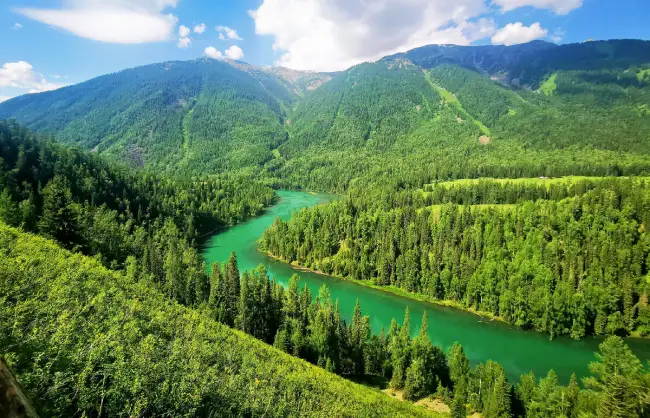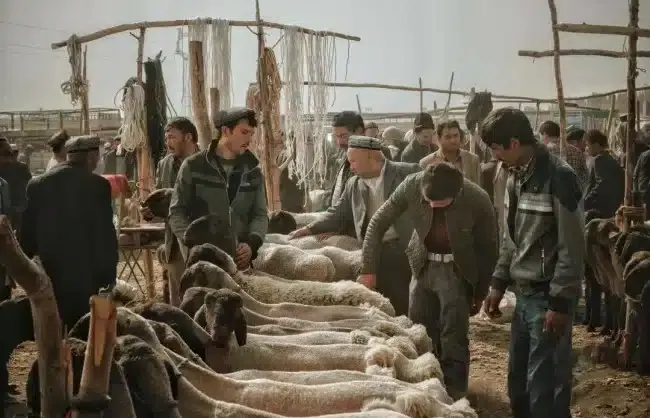Situated on the northwestern frontier of China, Xinjiang Uyghur Autonomous Region is known worldwide for its expansive lands, diverse and exotic cultures, and awe-inspiring natural marvels. It covers an immense area of 1.66 million square kilometers, which is about one-sixth of China’s total area.
Featuring a distinct topographical feature of “three mountains flanking two basins”, this enchanting territory is habitually divided into two parts: North Xinjiang and South Xinjiang. Though belong to the same region, each of these two parts displays distinct characteristics in natural landscapes, cultural diversities, historical narratives, etc.
When planning a travel to Xinjiang, some common questions are frequently asked. How to choose between South and North Xinjiang? And what are the differences between South and North Xinjiang? This article is here to answer your questions. As we will delve deep into the highlights of each part and cover distinct differences between these two parts.

Divide of North and South Xinjiang
The division of North and South Xinjiang is based on geographical differences, with the Tianshan Mountain Range as its demarcation line. Areas situated north of the Tianshan Mountain belong to North Xinjiang, while the areas south of it belong to South Xinjiang.
To delineate the two parts by city, then Korla and Turpan mark the demarcation line. That means places south of Korla and Turpan belong to South Xinjiang, and north of them belong to North Xinjiang.
Given the sheer scale and diversity of Xinjiang, exploring both South Xinjiang and North Xinjiang in a limited time should be a hard job. And it is recommended to travel to either the North or the South if you are short on time. To cover both parts, planning over 2 weeks for your Xinjiang tour is advisable.
Recommended In-depth Xinjiang Tours:
- 12 Days Xinjiang Silk Road Tour for Nature and Culture Tracing
- 14 Days Best Xinjiang Silk Road Tour of Ethnic Experience
Main Places in North and South Xinjiang
North Xinjiang: It occupies about one-third of Xinjiang’s total area. Mainly includes Ili Kazakh Autonomous Prefecture, Altay region, Tacheng region, Changji Hui Autonomous Prefecture, Urumqi City, and Bortala Mongol Autonomous Prefecture, etc. Boasts a relatively more diverse range of ethnic groups, with Kazakh, Han, Mongol and Hui peoples as the majority.
South Xinjiang: Makes up about two-thirds of Xinjiang’s total area. Mainly encompasses Kashgar, Hotan, Aksu, Bayingolin Mongol Autonomous Prefecture, and Kizilsu Kirghiz Autonomous Prefecture. Predominantly inhabited by the Uyghur people and other minority groups like Kirghiz and Tajik people.
Different Landscapes & Highlights
North Xinjiang:
The northern part of Xinjiang is characterized by its magnificent natural landscapes, being home to stunning forests, lush grasslands, plateau lakes, snow-capped mountains, etc. Some of the top tourist attractions in North Xinjiang include Kanas Lake, Ili Grasslands, Nalati and Bayinbuluk grasslands, and the nomadic lifestyle in the Altay region. Each of them offers quintessential views and changing seasonal beauties. You’ll love it if you seek breathtaking natural beauty and great photo opportunities.

South Xinjiang:
The southern part of Xinjiang is dominated by rich historic relics, immersive ethnic cultural experiences, and rugged natural landscapes. As home to widespread deserts and gobis, Southern Xinjiang features more wild natural landscapes, epitomized by the Taklamakan Desert and the Populus euphratica forests.
Regarding the cultural landscapes, Kashgar Ancient Town and Hotan are the two best destinations to look into a wealth of heritage from the ancient Silk Road and experience the intense ethnic customs and activities of Uyghurs and other minority ethnic groups.

Related reading:
Top Attractions in Northern Xinjiang
- Heavenly Lakeon Tianshan Mountain: About 1,900 meters above sea level; features crystal-clear waters being decorated by lush spruce trees and snow-capped peaks.
- Koktokay National Geopark: The first national geological park in China; famous for typical mineral deposits and mining heritage sites, peculiar seismic fault zones, charming lakes, forested mountains, etc.
- Colorful Beach (Wucaitan): Features vibrant colors and varied shapes on the almost barren riverbanks.
- Kanas Lake: Known for its breathtaking alpine vistas and the legendary “lake monster”; showcases ever-changing scenery in different seasons.
- Karamay Urho Ghost City: A collection of yardang landforms; showcases otherworldly landscape.
- Sayram Lake: A stunning alpine lake (the highest one in Xinjiang); features stunning water body, majestic snow-capped peaks and vast grasslands.
- Qiongkushitai Village: A hidden paradise surrounded by alpine forests and grasslands; where you can see pure wooden houses and the simple life of the Kazakh people.
- Nalati Grassland:Hailed as one of the world’s four great high-mountain valley grasslands; with towering snow mountains as background; a place to experience Kazakh culture.
- Bayinbuluke Prairie: The second-largest grassland in China; impressive for the “Nine Curves and Eighteen Bends” scenery formed by snow-fed rivers; offers lush grass, rolling hills, great hiking and stunning sunset.
- Duku Highway: Stretches 561 kilometers from Dushanzi to Kuqa; links north and south Xinjiang; displayschanging sceneries along the way, from snow-capped mountains and grasslands to canyons and deserts.
Best Northern Xinjiang Tours:
Top Attractions in Southern Xinjiang
- Kashgar Old City: The heart of Kashgar City; boasts over 2000 years of history; gain deep insights into Uyghur culture and life by immersing yourself in narrow alleys, exquisite mud-brick buildings, bustling bazaars, traditional teahouses, etc.
- Karakul Lake: An alpine gem surrounded by three highest peaks of the Pamir Mountains; about 3,652 above sea level; easily reached from Kashgar; features azure waters and a mixing view of dunes, oases, and snow-capped mountains.
- Stone City in Tashkurgan: one of the highest towns in the world; with an altitude of 3,700 meters above sea level; local Tajik ethnic groups still preserve their simple folkways.
- Tarim Poplar Forests: Tarim River Basin boasts the world’s largest inland river system, with the incredible Populus euphratica trees spanning across this area; shows stunning views in autumn when the leaves of Populus euphratica trees all turn into golden yellow.
Recommended Southern Xinjiang Tours:
Climate Contrasts & Best Times to Visit
Both North and South Xinjiang feature a large temperature variation between day and night and different seasons. While, still, these two parts show several distinct climate patterns:
North Xinjiang: The warm and moist air currents from the West Siberian region bless this part with relatively higher humidity and more precipitation (still less than most other places of China), especially in the mountainous areas.
Moreover, it experiences four distinct seasons, featuring cool summers, cold winters, and outstanding natural landscapes in springs and autumns. The best time for a North Xinjiang trip usually falls between April to February the next year.
South Xinjiang: The lower latitude and enclosed topography result in a drier climate and longer sunshine hours in South Xinjiang. It usually experiences arid conditions year-round, and features very hot summers and relatively mild winters. March to November is the best time for a South Xinjiang tour.

Transportation Considerations
Generally, North Xinjiang is easier to reach considering its more convenient and developed transportation system compared to South Xinjiang. See detailed information below:
North Xinjiang
Thanks to the earlier development in northern Xinjiang, this part offers more diverse and convenient transportation options for both air and land travel.
The major places like Urumqi, Yining, and Altay can all be reached by flights and high-speed trains. Moreover, the good conditions of highways and national roads make it easy to drive to remote attractions like Kanas and Ili Grasslands.
Intercity buses and direct tourist buses to popular attractions usually run frequently during the peak tourist season, this also contributes to your easy land transfer in Northern Xinjiang.
South Xinjiang
Though not as developed as North Xinjiang, the transportation network of South Xinjiang is also comprehensive. Visitors can reach its major destinations like Kashgar and Hotan by flights, trains, and buses. While most cities in South Xinjiang are more distant, making it more expensive to reach by flights and time-consuming by buses and trains.









